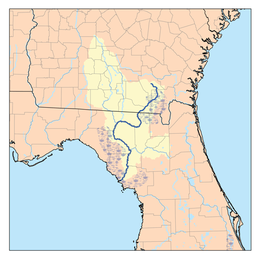Suwanee River
| Suwannee | |
| River | |
|
Suwannee River, Florida
|
|
| Country | United States |
|---|---|
| Tributaries | |
| - left | Santa Fe River |
| - right | Alapaha River, Withlacoochee River |
| Cities | Fargo, Georgia, White Springs, Florida, Branford, Florida |
| Source | Okefenokee National Wildlife Refuge |
| - location | Fargo, GA |
| Mouth | Gulf of Mexico |
| - location | Lower Suwannee National Wildlife Refuge, Suwannee, FL |
| - elevation | 0 ft (0 m) |
| - coordinates | 29°17′18″N 83°9′57″W / 29.28833°N 83.16583°WCoordinates: 29°17′18″N 83°9′57″W / 29.28833°N 83.16583°W |
| Length | 246 mi (396 km) |
|
Suwannee River Drainage Basin
|
|
The Suwannee River (also spelled Suwanee River) is a major river that runs through South Georgia southward into Florida in the southern United States. It is a wild blackwater river, about 246 miles (396 km) long. The Suwannee River is the site of the prehistoric Suwanee Straits which separated peninsular Florida from the panhandle.
The headwaters of the Suwanee River are in the Okefenokee Swamp in the town of Fargo, Georgia. The river runs southwestward into the Florida Panhandle, then drops in elevation through limestone layers into a rare Florida whitewater rapid. Past the rapid, the Suwanee turns west near the town of White Springs, Florida, then connects to the confluences of the Alapaha River and Withlacoochee River.
Starting at the confluences of those three rivers, that confluence forms the southern borderline of Hamilton County, Florida. The Suwanee then bends southward near the town of Ellaville, Florida followed by Luraville, Florida then joins together with the Santa Fe River (Florida) from the east south of the town of Branford, Florida.
The river ends and drains into the Gulf of Mexico on the outskirts of Suwannee, Florida.
The Spanish recorded the native Timucua name of Guacara for the river that would later become known as the Suwannee. Different etymologies have been suggested for the modern name.
The Suwannee River area has been inhabited by humans for thousands of years. During the first millennium CE, it was inhabited by the people of the Weedon Island archaeological culture, and around 900 CE, a derivative local culture, known as the Suwanee River Valley culture, developed.
...
Wikipedia


